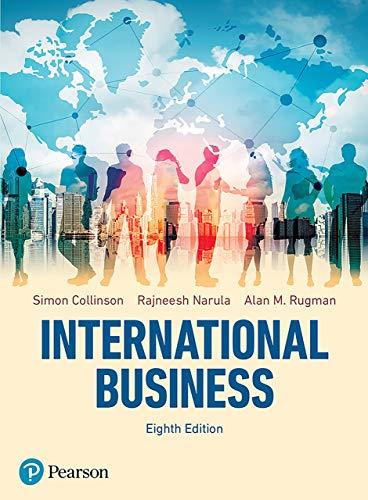One of the rules of international production strategy is: manufacture the highest-quality product and the world is
Question:
One of the rules of international production strategy is: manufacture the highest-quality product and the world is likely to beat a path to your door. A number of firms help illustrate this rule. One is Nike, the sports shoe and clothing producer. Making a wide variety of high-quality shoes, Nike catalogues more than 800 models for use in approximately 25 sports. In 1999 it had 35 per cent of the world’s market for training shoes (and 45 per cent in the United States) and these relative proportions have surprisingly not changed much. In 2017 its sales were $34.35 billion and it employed 73,100 employees. In an effort to keep ahead of the competition, Nike updates each shoe at least every six months. Most of these ideas are generated by Nike’s R&D centre in Beaverton, near Portland, Oregon, where physiologists and mechanical engineers study the stresses on an athlete’s feet and collaborate with stylists on new shoe ideas. Moreover in 2018, Nike is reported to sign a $144 million deal with in one of China’s (Chinese League of Legends) sporting competitions, which will cover clothing, accessories and shoes.
The aim of the takeover of Umbro on 3 March 2008 was to extend these scale advantages. Although Nike sells its products in over 140 countries and produces in more than 33 countries, it is really a triad MNE. In 2018, 43 per cent of Nike’s revenue was generated in the United States, 27 per cent from Europe, Middle East and Africa, and 30 per cent from Asia (including China) Pacific and Latin America. Sales in the United States including US sales of other businesses accounted for approximately 43 per cent of total revenues, which is remarkably consistent compared to 43 per cent in 2008. It has maintained a steady share of the global market and has remained focused on its core home market.
Nike’s high-quality production is matched by superb marketing skills. The world might be beating a path to Nike’s door, but the company makes sure the world knows where it is. It has been reported that Nike spends 11 per cent of its revenue on marketing, and its ‘swoosh’ brand is recognised the world over. The company continues to use sports stars to endorse its products and is responsible for some of the biggest athlete endorsement deals of all time, including sponsorship of Michael Jordan and LeBron James. A deal for James in 2015 was worth an estimated $30 million, but brought in over $340 million for Nike through the launch of a line of branded sneakers. Besides American stars like Tiger Woods it has used European soccer players, such as Cristiano Ronaldo, and cricket players in India. The idea is: if you can make the ‘cool’ guys wear your products, the rest will follow.
Perhaps the only thing Nike does not like to be remembered for is the bad publicity around its labour practices in Asia. Nike has outsourced all of its production to low-wage areas. By 2018, Nike supplied their goods from 452 factories (124 footwear factories and 328 apparel factories) and virtually all of Nike footwear was being produced by contract factories in Vietnam, China, Indonesia, Thailand and India. Nike also had manufacturing agreements with independent factories in Argentina, Brazil, Mexico and India to manufacture footwear for sales within those countries. In addition, all its apparel was produced in 33 host countries by independent contract manufacturers. Most of the apparel production occurred in China, Thailand, Indonesia, Malaysia, Vietnam, Sri Lanka, Turkey, Cambodia, El Salvador, Mexico and Taiwan. And NGOs have criticised the poor working conditions in some of its Asian factories, from Pakistani children stitching Nike’s soccer balls, to Vietnamese working in unsafe conditions. NGOs in the Western world started campaigns to boycott Nike, and demonstrators protested in front of Nike’s stores. Allegations of long working hours, bad ventilation and physical abuse of a mostly young female workforce have raised questions about Nike’s reputation.
Nike’s industry dominance was a main reason for its being severely targeted. Many of its competitors were found to have the same labour practices, but were not subjected to the same level of criticism. More recently Nike has acknowledged its corporate responsibility to improve working conditions in its own factories and help influence its suppliers.
Step by Step Answer:

International Business
ISBN: 9781292274157
8th Edition
Authors: Simon Collinson, Rajneesh Narula, Alan M. Rugman





